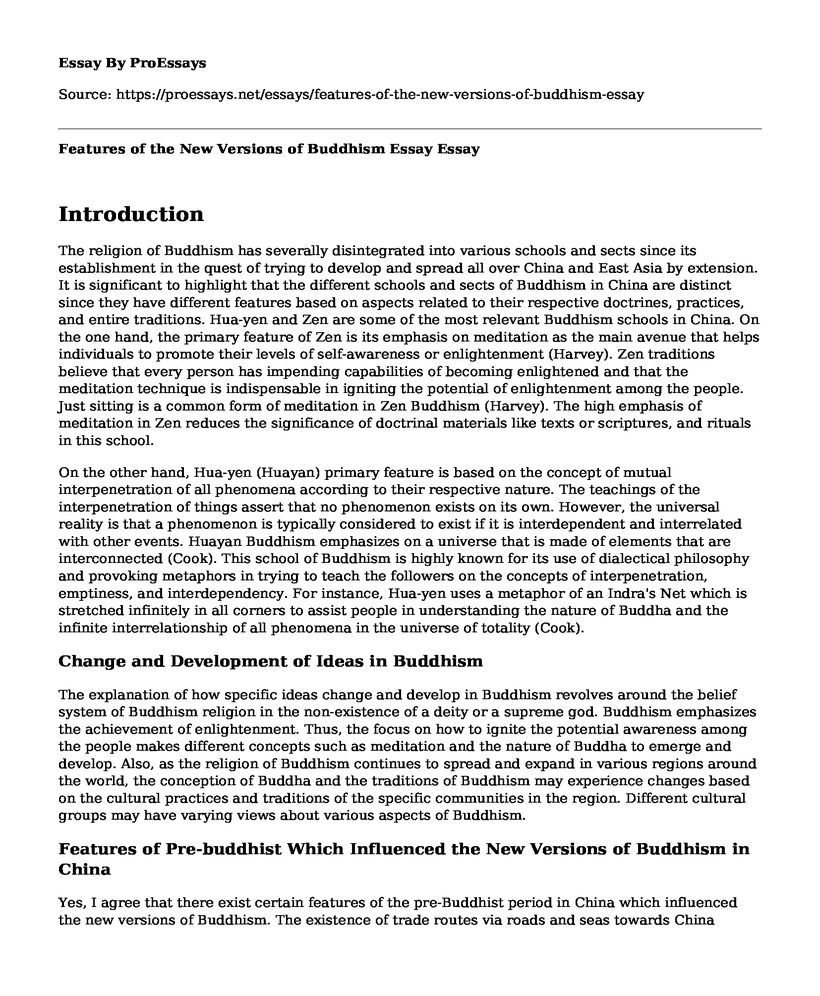Introduction
The religion of Buddhism has severally disintegrated into various schools and sects since its establishment in the quest of trying to develop and spread all over China and East Asia by extension. It is significant to highlight that the different schools and sects of Buddhism in China are distinct since they have different features based on aspects related to their respective doctrines, practices, and entire traditions. Hua-yen and Zen are some of the most relevant Buddhism schools in China. On the one hand, the primary feature of Zen is its emphasis on meditation as the main avenue that helps individuals to promote their levels of self-awareness or enlightenment (Harvey). Zen traditions believe that every person has impending capabilities of becoming enlightened and that the meditation technique is indispensable in igniting the potential of enlightenment among the people. Just sitting is a common form of meditation in Zen Buddhism (Harvey). The high emphasis of meditation in Zen reduces the significance of doctrinal materials like texts or scriptures, and rituals in this school.
On the other hand, Hua-yen (Huayan) primary feature is based on the concept of mutual interpenetration of all phenomena according to their respective nature. The teachings of the interpenetration of things assert that no phenomenon exists on its own. However, the universal reality is that a phenomenon is typically considered to exist if it is interdependent and interrelated with other events. Huayan Buddhism emphasizes on a universe that is made of elements that are interconnected (Cook). This school of Buddhism is highly known for its use of dialectical philosophy and provoking metaphors in trying to teach the followers on the concepts of interpenetration, emptiness, and interdependency. For instance, Hua-yen uses a metaphor of an Indra's Net which is stretched infinitely in all corners to assist people in understanding the nature of Buddha and the infinite interrelationship of all phenomena in the universe of totality (Cook).
Change and Development of Ideas in Buddhism
The explanation of how specific ideas change and develop in Buddhism revolves around the belief system of Buddhism religion in the non-existence of a deity or a supreme god. Buddhism emphasizes the achievement of enlightenment. Thus, the focus on how to ignite the potential awareness among the people makes different concepts such as meditation and the nature of Buddha to emerge and develop. Also, as the religion of Buddhism continues to spread and expand in various regions around the world, the conception of Buddha and the traditions of Buddhism may experience changes based on the cultural practices and traditions of the specific communities in the region. Different cultural groups may have varying views about various aspects of Buddhism.
Features of Pre-buddhist Which Influenced the New Versions of Buddhism in China
Yes, I agree that there exist certain features of the pre-Buddhist period in China which influenced the new versions of Buddhism. The existence of trade routes via roads and seas towards China played a significant role in the spread of Buddhism in China. These routes were used by Buddhist Monks and Missionaries who primarily originated from Central Asia and India and integrated Buddhism into the culture of the Chinese. One of the main pre-Buddhist Chinese factors that facilitated the successful spread and emergence of the new versions of Buddhism is the native Taoism. The Buddhist mainly relied upon the Taoism vocabulary through the use of the Chinese language and local religion to ensure that they translated the Buddhist scriptures into a form that could be read and comprehended by the Chinese. Taoism, therefore, enabled the Chinese to interpret Buddhist scriptures in their ways. The use of Taoism ensured that Buddhists could easily teach and spread the teachings of Buddhism in China.
References
Cook, F.H. (n.d). The Jewel Net of Indra.
Harvey, P. (n.d). Zen Meditation.
Cite this page
Features of the New Versions of Buddhism Essay. (2022, Feb 18). Retrieved from https://proessays.net/essays/features-of-the-new-versions-of-buddhism-essay
If you are the original author of this essay and no longer wish to have it published on the ProEssays website, please click below to request its removal:
- How Does Mark Use His Skill as a Storyteller To Present Jesus as a Savior?
- The Two Revelations Messages Before Hijra Essay
- Modernity: Integrating New Metaphysics, Theology Into Christianity - Essay Sample
- Essay Sample on Constantine's Contributions to Christianity and Its Impact Today
- Paper Example on Nutrition: A Vital Key to a Healthy Lifestyle
- Free Essay Example on Creation of Cosmos
- Brief Summary of Hinduism Essay Example







